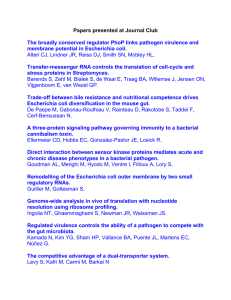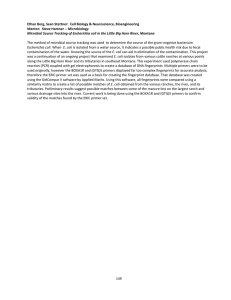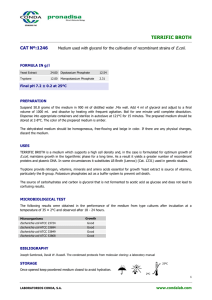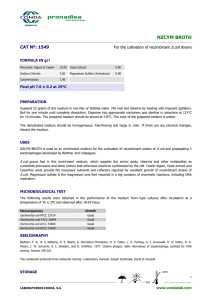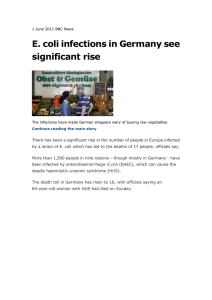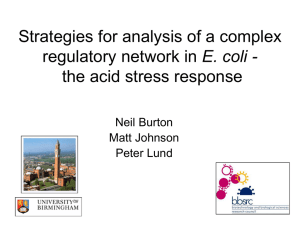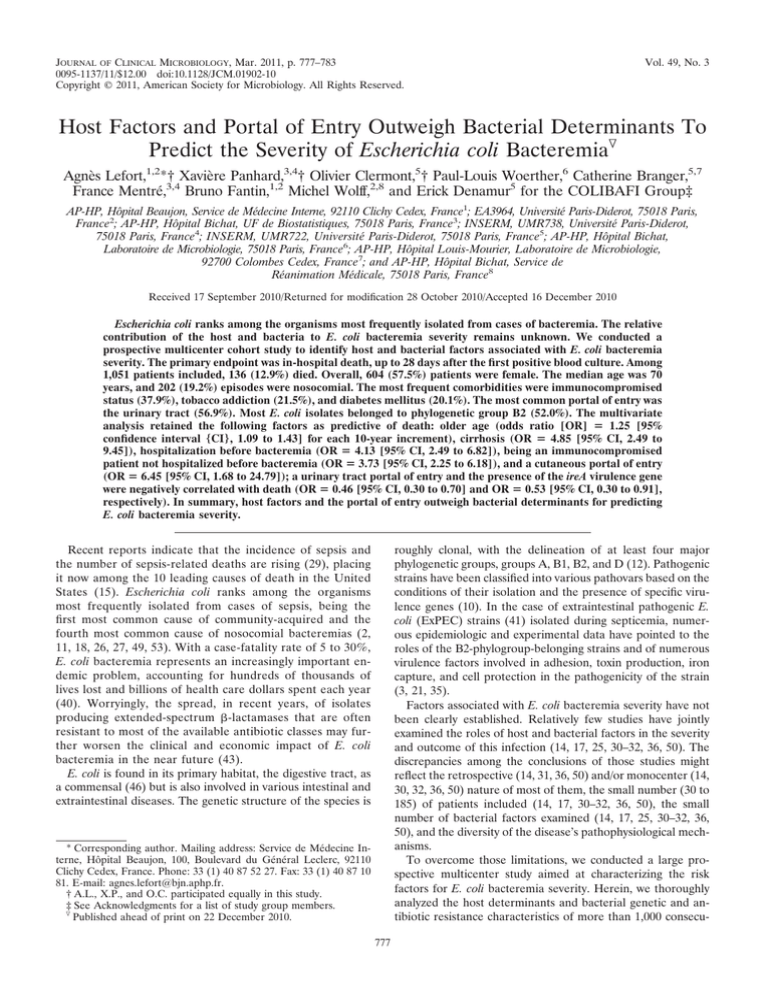
JOURNAL OF CLINICAL MICROBIOLOGY, Mar. 2011, p. 777–783
0095-1137/11/$12.00 doi:10.1128/JCM.01902-10
Copyright © 2011, American Society for Microbiology. All Rights Reserved.
Vol. 49, No. 3
Host Factors and Portal of Entry Outweigh Bacterial Determinants To
Predict the Severity of Escherichia coli Bacteremia䌤
Agnès Lefort,1,2*† Xavière Panhard,3,4† Olivier Clermont,5† Paul-Louis Woerther,6 Catherine Branger,5,7
France Mentré,3,4 Bruno Fantin,1,2 Michel Wolff,2,8 and Erick Denamur5 for the COLIBAFI Group‡
AP-HP, Hôpital Beaujon, Service de Médecine Interne, 92110 Clichy Cedex, France1; EA3964, Université Paris-Diderot, 75018 Paris,
France2; AP-HP, Hôpital Bichat, UF de Biostatistiques, 75018 Paris, France3; INSERM, UMR738, Université Paris-Diderot,
75018 Paris, France4; INSERM, UMR722, Université Paris-Diderot, 75018 Paris, France5; AP-HP, Hôpital Bichat,
Laboratoire de Microbiologie, 75018 Paris, France6; AP-HP, Hôpital Louis-Mourier, Laboratoire de Microbiologie,
92700 Colombes Cedex, France7; and AP-HP, Hôpital Bichat, Service de
Réanimation Médicale, 75018 Paris, France8
Received 17 September 2010/Returned for modification 28 October 2010/Accepted 16 December 2010
Escherichia coli ranks among the organisms most frequently isolated from cases of bacteremia. The relative
contribution of the host and bacteria to E. coli bacteremia severity remains unknown. We conducted a
prospective multicenter cohort study to identify host and bacterial factors associated with E. coli bacteremia
severity. The primary endpoint was in-hospital death, up to 28 days after the first positive blood culture. Among
1,051 patients included, 136 (12.9%) died. Overall, 604 (57.5%) patients were female. The median age was 70
years, and 202 (19.2%) episodes were nosocomial. The most frequent comorbidities were immunocompromised
status (37.9%), tobacco addiction (21.5%), and diabetes mellitus (20.1%). The most common portal of entry was
the urinary tract (56.9%). Most E. coli isolates belonged to phylogenetic group B2 (52.0%). The multivariate
analysis retained the following factors as predictive of death: older age (odds ratio [OR] ⴝ 1.25 [95%
confidence interval {CI}, 1.09 to 1.43] for each 10-year increment), cirrhosis (OR ⴝ 4.85 [95% CI, 2.49 to
9.45]), hospitalization before bacteremia (OR ⴝ 4.13 [95% CI, 2.49 to 6.82]), being an immunocompromised
patient not hospitalized before bacteremia (OR ⴝ 3.73 [95% CI, 2.25 to 6.18]), and a cutaneous portal of entry
(OR ⴝ 6.45 [95% CI, 1.68 to 24.79]); a urinary tract portal of entry and the presence of the ireA virulence gene
were negatively correlated with death (OR ⴝ 0.46 [95% CI, 0.30 to 0.70] and OR ⴝ 0.53 [95% CI, 0.30 to 0.91],
respectively). In summary, host factors and the portal of entry outweigh bacterial determinants for predicting
E. coli bacteremia severity.
roughly clonal, with the delineation of at least four major
phylogenetic groups, groups A, B1, B2, and D (12). Pathogenic
strains have been classified into various pathovars based on the
conditions of their isolation and the presence of specific virulence genes (10). In the case of extraintestinal pathogenic E.
coli (ExPEC) strains (41) isolated during septicemia, numerous epidemiologic and experimental data have pointed to the
roles of the B2-phylogroup-belonging strains and of numerous
virulence factors involved in adhesion, toxin production, iron
capture, and cell protection in the pathogenicity of the strain
(3, 21, 35).
Factors associated with E. coli bacteremia severity have not
been clearly established. Relatively few studies have jointly
examined the roles of host and bacterial factors in the severity
and outcome of this infection (14, 17, 25, 30–32, 36, 50). The
discrepancies among the conclusions of those studies might
reflect the retrospective (14, 31, 36, 50) and/or monocenter (14,
30, 32, 36, 50) nature of most of them, the small number (30 to
185) of patients included (14, 17, 30–32, 36, 50), the small
number of bacterial factors examined (14, 17, 25, 30–32, 36,
50), and the diversity of the disease’s pathophysiological mechanisms.
To overcome those limitations, we conducted a large prospective multicenter study aimed at characterizing the risk
factors for E. coli bacteremia severity. Herein, we thoroughly
analyzed the host determinants and bacterial genetic and antibiotic resistance characteristics of more than 1,000 consecu-
Recent reports indicate that the incidence of sepsis and
the number of sepsis-related deaths are rising (29), placing
it now among the 10 leading causes of death in the United
States (15). Escherichia coli ranks among the organisms
most frequently isolated from cases of sepsis, being the
first most common cause of community-acquired and the
fourth most common cause of nosocomial bacteremias (2,
11, 18, 26, 27, 49, 53). With a case-fatality rate of 5 to 30%,
E. coli bacteremia represents an increasingly important endemic problem, accounting for hundreds of thousands of
lives lost and billions of health care dollars spent each year
(40). Worryingly, the spread, in recent years, of isolates
producing extended-spectrum -lactamases that are often
resistant to most of the available antibiotic classes may further worsen the clinical and economic impact of E. coli
bacteremia in the near future (43).
E. coli is found in its primary habitat, the digestive tract, as
a commensal (46) but is also involved in various intestinal and
extraintestinal diseases. The genetic structure of the species is
* Corresponding author. Mailing address: Service de Médecine Interne, Hôpital Beaujon, 100, Boulevard du Général Leclerc, 92110
Clichy Cedex, France. Phone: 33 (1) 40 87 52 27. Fax: 33 (1) 40 87 10
81. E-mail: agnes.lefort@bjn.aphp.fr.
† A.L., X.P., and O.C. participated equally in this study.
‡ See Acknowledgments for a list of study group members.
䌤
Published ahead of print on 22 December 2010.
777
778
LEFORT ET AL.
tive E. coli bacteremia episodes occurring in adults over a
1-year period.
(This work was presented in part at the 49th International
Conference on Antimicrobial Agents and Chemotherapy, San
Francisco, CA, 12 to 15 September 2009 [26a].)
MATERIALS AND METHODS
Study design and setting. This prospective COLIBAFI study was conducted in
15 French hospitals (1 general and 14 university hospitals). Adults with E. coli
bacteremia between January and December 2005 were enrolled in the study.
Only patients receiving vasopressors before the onset of E. coli bacteremia or
patients already included in the study for a previous episode were not considered
for inclusion.
E. coli bacteremia was defined as the isolation of E. coli from ⱖ1 set of
aseptically inoculated blood culture bottles. The primary endpoint was in-hospital death, up to 28 days after the first positive blood culture.
Clinical and bacteriological data were collected in each center at the time of
bacteremia by a dedicated physician and microbiologist in tandem. All E. coli
isolates were centralized in 1 research laboratory (INSERM, UMR722), which
performed molecular epidemiology studies. The study was approved by the
institutional Ethics Committee (Comité de Protection des Personnes, Hôpital
Saint-Louis, Paris, France; approval number 2004-06).
Clinical characteristics. Bacteremia episodes were defined as being nosocomial when the first positive blood culture was obtained ⱖ48 h following hospital
admission. Otherwise, bacteremia was considered community acquired.
Immunocompromised patients were those presenting at least 1 of the following conditions: human immunodeficiency virus (HIV) infection with CD4 counts
of ⬍200 cells/mm3, underlying progressive solid cancer or malignant hemopathy,
prior solid-organ or bone marrow transplantation, neutropenia of ⬍500/mm3,
congenital immunodeficiency, current immunosuppressive therapy (ⱖ10 mg/day
of a prednisone equivalent, immunomodulating treatment, or antineoplastic
chemotherapy within the last month).
The portal of entry was established according to compatible clinical and/or
radiographic features and the isolation of E. coli from the presumed source of
infection. When E. coli could not be isolated from the presumed portal of entry
(i.e., previous antibiotic treatment leading to negative bacterial cultures or an
undesirable invasive procedure needed to isolate E. coli from the portal of entry),
the presumed portal of entry was assigned on the basis of a firm clinical suspicion, provided that all other possible sources of infection had been excluded. If
the clinical data were ambiguous, the portal of entry was categorized as being
“undetermined.” A secondary septic focus was defined as a metastatic focus of
infection due to bacteremia that was anatomically distant from the portal of
entry, if any.
The bacteremia was polymicrobial when at least 1 other microorganism was
recovered from a set of blood culture bottles positive for E. coli. The antibiotic
regimen was considered to be adequate when the E. coli isolate was susceptible
in vitro to at least 1 of the antibiotics given.
Follow-up ended at hospital discharge or 28 days after the first E. colipositive blood culture for patients still hospitalized 28 days after the bacteremia diagnosis.
Bacterial determinants. Strains were assigned to 1 of the 4 main E. coli
phylogenetic groups, i.e., groups A, B1, B2, and D, using a triplex PCR developed previously by Clermont et al. (6). The presence of 18 virulence factors
representative of the main classes of identified E. coli extraintestinal virulence
determinants (8, 20, 38, 39, 45), including adhesins (papC; papG, including papG
alleles; sfa/foc; iha; hra; and ibeA), toxins (hlyC, cnf1, and sat), iron capture
systems (fyuA, irp2, iroN, iucC, and ireA), protectins (neuC, chromosomal ompT,
and traT), as well as a gene encoding a uropathogenic-specific protein, usp (24),
were tested by PCR, as previously described (19). For each isolate, a virulence
score, defined as the number of virulence factors present over the 18 tested, was
calculated. As it is well known that numerous virulence genes are clustered on
genomic islands called pathogenicity-associated islands (PAIs) (13), we deduced
the presence of 6 PAIs from the presence of the individual virulence genes (4, 16,
24): PAIICFT073 (papGII, hly, and iucC positive), PAIIIJ96 (presence of at least 3
of the 4 following genes: papGIII, hly, cnf1, and hra), PAIIII536 (sfa/foc and iroN
positive), PAIIV536, a high-pathogenicity island (HPI) (irp2 and fyuA positive),
GimA (ibeA positive), and PAIUSP (usp positive). For each isolate, a PAI score,
defined as the number of PAIs present over the 6 tested, was calculated.
Antimicrobial susceptibilities were determined for 18 antibiotics in each center
with the disk diffusion method with Mueller-Hinton agar, as recommended by
Comité de l’Antibiogramme de la Société Française de Microbiologie standards
J. CLIN. MICROBIOL.
(http://www.sfm.asso.fr). A strain was considered to be resistant to expandedspectrum cephalosporins if it was resistant to cefotaxime and/or ceftazidime
according to MICs determined by the Etest diffusion method (AB Biodisk, Solna,
Sweden) (9). A strain was considered to be multidrug resistant when it was
resistant to at least amoxicillin, ofloxacin, and cotrimoxazole. For each strain, a
resistance score was defined as the number of antibiotics to which it was resistant
over the 5 following drugs: amoxicillin, cefotaxime, gentamicin, ofloxacin, and
cotrimoxazole. The presence of integrons (classes I, II, and III), which are
molecular markers of resistance, were detected by triplex real-time PCR (44).
Statistical methods. Based on previous reports, the expected proportion of
death was 15% (17, 25, 30, 53). We therefore planned to include 1,000 patients.
With 150 deaths and based on the general rule of 10 events by covariate, that
number was needed to test about 15 clinical characteristics and 15 bacterial
determinants.
The risk factors associated with death were analyzed. First, univariate regression analyses were performed for clinical and bacteriological factors. The studied
clinical factors were age; sex; place of birth; weight; body mass index; hospitalization before bacteremia; antibiotic therapy during the 2 weeks preceding bacteremia; comorbidities, including a history of bacteremia, pregnancy, chronic
alcoholism, tobacco addiction, congestive heart failure, chronic respiratory insufficiency, chronic renal insufficiency, cystic fibrosis, diabetes mellitus, sickle-cell
anemia, immunocompromise, cirrhosis, or hemochromatosis; nosocomial infection; a portal of entry including urinary tract, digestive tract, pulmonary, cutaneous, venous catheter, female genital tract, or surgical site; and prescription of
an adequate antibiotic regimen within the first day. The bacteriological determinants were as follows: a phylogenetic group in 4 classes; group B2; the presence of each of the 18 virulence factors; virulence score; the presence of each of
the 6 PAIs; PAI score; polymicrobial sample; resistance to each of the drugs
amoxicillin, cefotaxime, gentamicin, ofloxacin, and cotrimoxazole; resistance to
expanded-spectrum cephalosporins; multidrug resistance; resistance score; and
the presence of an integron of classes I, II, and/or III. The clinical and bacteriological risk factors achieving a P value of ⬍0.10 were then entered into the
multivariate logistic regression model. A backward selection method was used to
obtain a model in which all clinical risk factors had a P value of ⬍0.05. After that
selection step, all interactions between 2 variables were tested, and all significant
ones were retained in the model. The predictability of the final model was
assessed by using the C statistic.
The risk factors for death were then also analyzed for the 2 subgroups of
patients with the most frequent portals of entry, i.e., urinary or digestive tract,
using an approach similar to that described above. Comparisons of some factors
between urinary or digestive tract portals of entry were performed by using a
Wilcoxon test for continuous variables and the Fisher exact test for discrete
variables.
All these analyses were done with SAS 9.1 software (SAS Institute Inc., Cary, NC).
RESULTS
Among the 1,099 patients included in the study, 48 were
excluded from the analysis because the E. coli isolates were not
available (n ⫽ 18) or the patient’s clinical research forms were
not filled out (n ⫽ 30). Thus, 1,051 patients were retained for
the analysis.
Clinical characteristics. The characteristics of the patients
with E. coli bacteremia are shown in Table 1. The patients were
mostly ⬎65 years old (638 patients [60.7%]) and predominantly female (57.5%). Overall, 19.2% of the bacteremias were
nosocomial infections, and 9.1% occurred in patients living in
nursing or retirement homes or a long-term care facility. At
least one underlying immunocompromising comorbidity was
reported for 37.9% of the patients. As expected, the most
frequent portal of entry was the urinary tract (56.9% of the
cases); a digestive tract portal of entry was identified for 13.1%
of patients. Among 598 patients with a urinary tract source, 173
were male (including cases of presumed prostatitis [134 patients], pyelonephritis [32], and orchiepididymitis [6]) and 425
were female (all pyelonephritides). Among 138 patients with a
digestive tract portal of entry, biliary tract infections predominated (angiocholitis [76 patients] and cholecystitis [33] but
VOL. 49, 2011
SEVERITY OF ESCHERICHIA COLI BACTEREMIA
TABLE 1. Demographic, epidemiological, and clinical
characteristics of the 1,051 patients
with E. coli bacteremia
Characteristic
Valueb
Demographics
Median age (yr) (range) ......................................................
70 (18–101)
No. (%) of males/no. (%) of females ................................447 (42.5)/604 (57.5)
No. (%) of patients with a place of birth of:
Europe ...............................................................................
918 (87.4)
Africa .................................................................................
71 (6.8)
Asia.....................................................................................
8 (0.8)
America..............................................................................
3 (0.3)
Unknown ...........................................................................
51 (4.9)
Origin of infection 关no. (%) of patients兴
Patients with stay prior to bacteremia...............................
Home .................................................................................
Institution ..........................................................................
Hospital..............................................................................
Nosocomial infection ...........................................................
Antibiotics within 2 wk preceding bacteremia..................
Clinical 关no. (%) of patients兴
Host predisposing conditionsa
Solid cancer .......................................................................
Malignant hemopathy ......................................................
Tobacco addiction ............................................................
Diabetes mellitus ..............................................................
Chronic renal insufficiency ..............................................
Congestive heart failure...................................................
Chronic alcoholism...........................................................
Prior bacteremia ...............................................................
Cirrhosis.............................................................................
HIV infection ....................................................................
Immunocompromisea .......................................................
Progressive solid cancer/hemopathy...........................
Antiproliferative chemotherapy..................................
Past solid-organ or bone marrow transplant ............
Current corticosteroid therapy ...................................
Current immunomodulating treatment .....................
Neutropenia ⬍500/mm3 ...............................................
HIV infection with ⬍200 CD4 cells/mm3 .................
Congenital immunodeficiency .....................................
Portal of entry
Urinary tract......................................................................
Digestive tract ...................................................................
Respiratory tract...............................................................
Venous catheter................................................................
Cutaneous..........................................................................
Surgical site .......................................................................
Female genital tract .........................................................
Two portals of entry.........................................................
Not determined.................................................................
Start of adequate antibiotic therapy
ⱕ1 day after bacteremia..............................................
690 (65.9)
95 (9.1)
262 (25.0)
202 (19.2)
176 (16.8)
239 (23.5)
106 (10.3)
216 (21.5)
205 (20.1)
150 (14.8)
133 (13.1)
127 (12.6)
80 (7.9)
52 (5.2)
17 (1.7)
398 (37.9)
321 (30.5)
128 (12.2)
66 (6.6)
78 (7.4)
71 (7.0)
62 (6.1)
5 (0.5)
2 (0.2)
598 (56.9)
138 (13.1)
19 (1.8)
11 (1.1)
10 (1.0)
5 (0.5)
7 (0.7)
19 (1.8)
282 (26.8)
758 (72.1)
Some patients had ⬎1 host predisposing condition and/or criterion for their
immunocompromised status.
b
Because of missing values, percentages are calculated based on available
data.
a
also pancreatitis [23], peritonitis [13], diverticulitis [10], appendicitis [4], and liver abscess [4]). Overall, 30 (2.9%) patients
had at least 1 secondary septic focus of infection.
Bacterial determinants. E. coli was isolated alone from the
blood cultures of 988 patients, whereas for 63 (6.0%) patients
bacteremias were polymicrobial. Five hundred forty-six strains
(52.1%) and 219 strains (21.0%) belonged to the classical extraintestinal pathogenic E. coli phylogenetic groups (35), i.e.,
groups B2 and D, respectively; 236 (22.5%) belonged to phylogenetic group A, and only 48 (4.6%) belonged to group B1.
The frequencies of the various virulence factors were highly
variable, ranging from 8.3% for ibeA to 76.7% for irp2, a gene
belonging to the high-pathogenicity island (42) (Fig. 1A). The
median virulence score for isolates was 9 (range, 0 to 18).
Likely, the frequencies of PAIs ranged from 8.3% for GimA to
779
76.6% for the HPI, with PAIICFT073, PAIIIJ96, PAIIII536, and
PAIUSP at 13, 18.7, 25.3, and 57.2%, respectively. The median
PAI score for isolates was 2 (range, 0 to 6).
Rates of resistance to each antibiotic are shown in Fig. 1B;
108 strains (10.3%) were multidrug resistant. Strains had a
median resistance score of 1, ranging from no resistance to
resistance to all the antibiotics tested; 39 (3.7%) were resistant
to expanded-spectrum cephalosporins, among which 76.9%
were community acquired. Three hundred fifteen strains
(30.0%) possessed at least 1 integron, predominantly class I
integrons (294 strains); a few class II (24 strains) and no class
III integrons were detected.
Risk factors for death. Overall, 136 (12.9%) patients died.
The median time to death was 6 days (range, 0 to 28). Clinical
and bacterial factors associated with death were identified by
univariate and multivariate analyses. The 13 clinical and 16
bacteriological risk factors significant in univariate analyses are
reported in Table 2. A significant interaction between immunocompromise and hospitalization before bacteremia was also
entered into the model and yielded a new variable with 3
classes: not immunocompromised and not hospitalized before
bacteremia, immunocompromised and not hospitalized before
bacteremia, and hospitalized before bacteremia with or without immunocompromise; their corresponding odds ratios
(ORs) (and 95% confidence intervals [CIs]) are reported in
Table 2.
After backward selection in the multivariate model, risk
factors associated with death were older age, cirrhosis, hospitalization before bacteremia, immunocompromised patients
not hospitalized before bacteremia, and a cutaneous portal of
entry, whereas a urinary tract portal of entry and the presence
of the bacteriological ireA virulence factor were negatively
correlated with death (Table 2). The C statistic of the final
model was 0.77 (95% CI, 0.73 to 0.81) and was similar for the
model with the same clinical factors but without the virulence
factor ireA. These results show the good predictability of the
model and the limited added value of the virulence factor in
addition to clinical risk factors.
Relationship among portal of entry, host characteristics,
and bacterial determinants. Because the urinary and the digestive tracts were the most frequently found portals of entry,
and the pathophysiologies of E. coli bacteremias originating
from the urinary or the digestive tract differ markedly, episodes
were analyzed separately according to their urinary or digestive
tract origin. Only isolates originating from patients with a single source (urinary or digestive tract) were considered for
these subgroup analyses.
There were significantly more group B2 isolates among isolates of urinary tract origin (360/581 [62%]) than among those
of digestive origin (43/129 [33.3%]) (P ⬍ 0.001). Virulence and
PAI scores were significantly higher for isolates originating
from the urinary tract than those from the digestive tract (medians, 10 [range, 0 to 17] and 2 [range, 0 to 6] versus 5 [range,
0 to 15] and 1 [range, 0 to 5], respectively; P ⬍ 0.001), whereas
resistance scores did not differ (median, 1 [range, 0 to 5] for
both portals of entry). All but 2 (traT and ibeA) of the 18
extraintestinal virulence factors and all but GimA of the PAIs
analyzed were significantly more frequently found among isolates of urinary tract origin than among those of digestive tract
origin (P ⬍ 0.05).
780
LEFORT ET AL.
J. CLIN. MICROBIOL.
FIG. 1. Virulence factors and resistance to antibiotics of 1,051 E. coli isolates according to the portal of entry of the bacteremia. (A) Percentages of isolates harboring any of the 19 extraintestinal virulence factors tested (the papGII and papGIII alleles are individualized here).
(B) Percentage of isolates resistant to the 18 antibiotics tested.
The rate of death was higher among patients whose sepsis
was of digestive tract origin (14.7%) than among those whose
sepsis was of urinary tract origin (7.6%) (P ⫽ 0.002). Table 3
reports the results of the multivariate analyses according to the
urinary or digestive tract portal of entry. Clinical factors associated with death from sepsis of urinary tract origin were the
same as those retained in the global model (Table 2), plus
tobacco addiction. No bacteriological factor was retrieved in
this subgroup. For the subgroup with a digestive tract portal of
entry, only cirrhosis and polymicrobial bacteremia were associated with death.
DISCUSSION
Through the prospective, multicenter, cohort COLIBAFI
study, we thoroughly analyzed detailed host characteristics and
numerous bacterial determinants that could potentially influence the E. coli bacteremia severity of ⬎1,000 episodes. Our
study was conducted during a recent 1-year period and thus
provides original clinical and molecular epidemiological data
on current aspects of E. coli bacteremia.
The results of our multivariate analyses showed that death
was strongly associated with certain patient characteristics:
older age, cirrhosis, hospitalization before bacteremia, and immunocompromised status for patients not hospitalized before
the episode. Previous studies identified advanced age, health
care or hospital acquisition, and comorbidities as host determinants associated with a poor outcome (25, 30, 36). Surprisingly, a cutaneous portal of entry was also predictive of lifethreatening disease. E. coli isolates from skin and soft tissue
infections usually belong to phylogenetic group B2 and have a
high virulence potential (34), but a link between that origin and
VOL. 49, 2011
SEVERITY OF ESCHERICHIA COLI BACTEREMIA
781
TABLE 2. Risk factors for death from E. coli bacteremia identified by univariate and multivariate analyses
Value for group
Risk factord
Clinical
Median age (yr) (range)
No. (%) of patients
Male
Tobacco addiction
Chronic alcoholism
Cirrhosis
Nosocomial infection
Hospitalized before bacteremiab
Immunocompromisedb
Not I, not H, before Bc
H before B ⫹/⫺ Ic
I, not H, before Bc
Portal of entry
Urinary
Venous catheter
Cutaneous
Bacteriological
No. (%) of patients with polymicrobial
infection
No. (%) of patients with B2 phylogenetic
group infection
Median virulence score (range)
No. (%) of patients with virulence factor
papGII
papC
ireA
hra
irp2
fyuA
neuC
traT
usp
iroN
Median PAI score (range)
No. (%) of isolates with expanded-spectrum
cephalosporin resistance
No. (%) of isolates with multidrug
resistance
Univariate analysis
Multivariate analysis
Nonsurvivors
(n ⫽ 136)
Survivors (n
⫽ 915)
OR (95% CI)
P value
OR (95% CI)
P value
72 (28–99)
70 (18–101)
1.13 (1.01–1.26)a
0.0267
1.25 (1.09–1.43)a
0.0019
72 (52.94)
37 (28.24)
27 (20.61)
18 (13.64)
42 (30.88)
55 (40.74)
79 (58.09)
34 (25.19)
55 (40.74)
46 (34.07)
375 (40.98)
179 (20.46)
100 (11.35)
34 (3.88)
160 (17.49)
207 (22.70)
319 (34.86)
507 (55.59)
207 (22.70)
198 (21.71)
1.62 (1.13–2.33)
1.53 (1.01–2.32)
2.03 (1.27–3.25)
3.91 (2.14–7.15)
2.11 (1.41–3.15)
2.34 (1.61–3.41)
2.59 (1.79–3.74)
1
3.96 (2.51–6.26)
3.46 (2.16–5.56)
0.0089
0.0441
0.0033
⬍.0001
0.0003
⬍.0001
⬍.0001
–
⬍.0001
⬍.0001
4.85 (2.49–9.45)
⬍.0001
1
4.13 (2.49–6.82)
3.73 (2.25–6.18)
–
⬍.0001
⬍.0001
47 (34.56)
4 (2.94)
4 (2.94)
551 (60.22)
7 (0.77)
6 (0.66)
0.35 (0.24–0.51)
3.93 (1.14–13.61)
4.59 (1.28–16.49)
⬍.0001
0.0308
0.0194
0.46 (0.30–0.70)
0.0002
6.45 (1.68–24.79)
0.0066
17 (12.50)
46 (5.03)
2.70 (1.50–4.86)
0.0009
57 (41.91)
489 (53.56)
0.63 (0.44–0.90)
0.0117
6 (0–15)
9 (0–17)
0.91 (0.88–0.95)
⬍.0001
30 (22.06)
43 (31.62)
21 (15.44)
64 (47.06)
90 (66.18)
90 (66.18)
19 (13.97)
74 (54.41)
59 (43.38)
66 (48.53)
1 (0–5)
12 (8.82)
376 (41.18)
482 (52.79)
281 (30.78)
571 (62.54)
715 (78.31)
713 (78.09)
204 (22.34)
592 (64.84)
494 (54.11)
538 (58.93)
2 (0–6)
27 (2.95)
0.40 (0.26–0.62)
0.41 (0.28–0.61)
0.41 (0.25–0.67)
0.53 (0.37–0.77)
0.54 (0.37–0.80)
0.55 (0.37–0.81)
0.56 (0.34–0.94)
0.65 (0.45–0.93)
0.65 (0.45–0.94)
0.66 (0.46–0.94)
0.85 (0.75–0.95)
3.18 (1.57–6.45)
⬍.0001
⬍.0001
0.0003
0.0007
0.0020
0.0025
0.0277
0.0190
0.0201
0.0227
0.0064
0.0013
0.53 (0.30–0.91)
0.0205
21 (15.44)
87 (9.51)
1.74 (1.04–2.91)
0.0354
a
Age by 10 years.
A significant interaction between these two factors was found in the univariate analysis. Therefore, for the multivariate analysis, a new variable with 3 classes was
created.
c
The 3 classes formed as a result of the significant interaction between the 2 risk factors hospitalization before bacteremia and immunocompromise.
d
H, hospitalized; B, bacteremia; I, immunocompromised; ⫹/⫺, with or without.
b
E. coli bacteremia severity was never suggested previously.
This result must be taken cautiously, as only 10 patients with a
cutaneous portal of entry were included in the study. In contrast, a urinary tract portal of entry was associated with a less
severe outcome, as previously reported (17, 25, 30, 36).
The only bacterial determinant that significantly influenced
prognosis, although at a lower level than that of clinical determinants, was the presence of the ireA gene, which was found to
negatively correlate with death (Table 2). The ireA (iron-responsive element) gene encodes a peptide (IreA) suggested to
be involved in iron acquisition and to be important in urovirulence (39). IreA has been used with success as an immunizing
agent in urinary tract infections (1) and bacteremia (52) in
mice. Interestingly, this gene can be physically linked to the
papC (pyelonephritis-associated pilus) gene and the papGII
allele in the E. coli genome (22, 48), both also involved in
urinary tract infection and subsequent bacteremia (23, 33). In
our analysis, these two determinants have odds ratios similar to
those of ireA in the univariate analysis (Table 2). Thus, this
part of the E. coli genome plays a crucial role in the occurrence
of kidney infection and subsequent bacteremia but not in the
latter’s severity. These bacterial determinants are markers of
the urinary tract origin of the bacteremia, which is associated
with a better prognosis. Our findings indicate that host factors
and portal of entry outweigh bacterial determinants in predicting the severity of E. coli bacteremia. The good predictability
of the model with 6 clinical risk factors encourages the building
of a prognostic score of death following bacteremia, which
should be prospectively evaluated.
We then postulated that risk factors predictive of death
might differ according to the portal of entry. For a urinary tract
origin, the host characteristics predictive of death were the
782
LEFORT ET AL.
J. CLIN. MICROBIOL.
TABLE 3. Risk factors for death from E. coli bacteremia according to the portal of entry
Portal of entry and variablec
Urinary tract (n ⫽ 581)
Median age (yr) (range)
No. (%) of patients
Tobacco addiction
Cirrhosis
Not I, not H, before Bb
H before B ⫹/⫺ I
I, not H, before B
Digestive tract (n ⫽ 129) 关no. (%) of patients兴
Cirrhosis
Polymicrobial
Value for groupd
Survivors
Multivariate analysis OR
(95% CI)
P value
Nonsurvivors
(n ⫽ 44)
76 (43–99)
(n ⫽ 537)
70 (18–101)
1.48 (1.16–1.89)a
0.0019
2.4 (1.11–5.01)
7.0 (2.48–19.85)
1
4.34 (1.92–9.82)
3.87 (1.69–8.87)
0.0251
0.0002
–
0.0004
0.0014
4.20 (1.07–16.41)
4.29 (1.22–15.15)
0.0392
0.0235
14 (33.33)
7 (16.67)
14 (32.56)
16 (37.21)
13 (30.23)
86 (16.48)
17 (3.26)
342 (64.04)
91 (17.04)
101 (18.91)
(n ⫽ 19)
4 (22.22)
5 (26.32)
(n ⫽ 110)
9 (8.57)
11 (10.00)
a
Age by 10 years.
The 3 classes formed as a result of the significant interaction between the 2 risk factors of hospitalization before bacteremia and immunocompromise.
c
H, hospitalized; B, bacteremia; I, immunocompromised; ⫹/⫺, with or without.
d
For a urinary tract portal of entry, there were 44 nonsurvivors and 537 survivors. For a digestive tract portal of entry, there were 19 nonsurvivors and 110 survivors.
b
same as those retained in the overall analysis, plus tobacco
addiction. No bacterial determinant was identified. For the
digestive tract origin, cirrhosis was associated with life-threatening bacteremia. Cirrhotic patients have impaired mechanisms of hepatosplenic clearance (7) and are at an increased
risk of bacteremia caused by poorly virulent strains colonizing
the digestive tract. It was previously reported that the bacteremia prognosis for cirrhotic patients is highly guarded (5, 47).
We also found a link between the polymicrobial character of
the bacteremia and death. It was previously shown that polymicrobial bacteremia was associated with higher mortality rates
than unibacterial infection (37, 51), but no previous studies
evidenced this parameter as a risk factor for death in a subgroup of patients with a digestive tract source of bacteremia.
Our study has several limitations. First, we did not analyze
the impact of host genetic factors, which could have played a
role in the severity of E. coli bacteremia. Second, we were
unable to determine the portal of entry for 26.8% of the episodes. Third, although we looked at 18 virulence factors, either
individually or grouped into PAIs, we are far from having
tested all the genes of the variable E. coli gene pool (48) and
their different combinations. It was shown from the complete
sequence analysis of some natural isolates that multiple constellations of genes can lead to a virulent phenotype (48).
High-throughput sequencing technologies (28) will allow the
performance of comparative genomic analyses on numerous
strains and the performance of phenotype-genotype association studies in the near future.
Despite these limitations, our analysis based on 15 centers
and ⬎1,000 patients, and its prospective design, enhanced our
ability to draw conclusions. Death following E. coli bacteremia
is associated mainly with host characteristics and the portal of
entry. Thus, the early identification of clinical risk factors for
severe progression is essential to optimize the timely management of patients with E. coli bacteremia.
ACKNOWLEDGMENTS
This study received grants from Réseau de Recherche Clinique
(INSERM grant RBM-03-58) and the Projet Hospitalier de Recherche
Clinique (Assistance Publique-Hôpitaux de Paris grant AOR 04 053).
The sponsors (INSERM and Assistance Publique-Hôpitaux de Paris)
had no role in designing and conducting the study; collection, management analysis, and interpretation of the data; or preparation, review, or approval of the manuscript.
We do not declare any conflicts of interest.
Members of the COLIBAFI Group in France include the following
individuals. Clinical investigators are Michel Wolff, Loubna Alavoine,
Xavier Duval, David Skurnik, Paul-Louis Woerther, and Antoine Andremont (CHU Bichat-Claude-Bernard, Paris); Etienne Carbonnelle,
Olivier Lortholary, and Xavier Nassif (CHU Necker-Enfants Malades,
Paris); Sophie Abgrall, Françoise Jaureguy, and Bertrand Picard
(CHU Avicenne, Bobigny); Véronique Houdouin, Yannick Aujard,
Stéphane Bonacorsi, and Edouard Bingen (CHU Robert-Debré, Paris); Agnès Meybeck, Guilène Barnaud, and Catherine Branger (CHU
Louis-Mourier, Colombes); Agnès Lefort, Bruno Fantin, Claire Bellier, Frédéric Bert, and Marie-Hélène Nicolas-Chanoine (CHU Beaujon, Clichy); Bernard Page, Julie Cremniter, and Jean-Louis Gaillard
(CHU Ambroise-Paré, Boulogne-Billancourt); Bernard Garo, Séverine Ansart, Geneviève Herry-Arnaud, and Didier Tandé (CHU Brest,
Brest); Jean-Claude Renet, René Ze Bekolo, Renaud Verdon, and
Roland Leclercq (CHU Caen, Caen); Claire de Gialluly, Jean-Marc
Besnier, Laurent Mereghetti, and Roland Quentin (CHU Tours,
Tours); Achille Kouatchet, Alain Mercat, and Marie Laure Joly-Guillou (CHU Angers, Angers); Catherine Dalebroux, Pascal Chavanet,
and Catherine Neuwirth (CHU Dijon, Dijon); Camille Colliard, Martin Dary, Gilles Potel, and Jocelyne Caillon (CHU Nantes, Nantes);
Françoise Leturdu, Jean-Pierre Sollet, and Gaëtan Plantefève (CH
Argenteuil, Argenteuil); and Agnès de Patureaux, Pierre Tattevin, and
Pierre-Yves Donnio (CHU Rennes, Rennes). Those responsible for
bacterial genotyping are Erick Denamur, Olivier Clermont, Christine
Amorin, and Jeremy Glodt (INSERM, UMR722, Université ParisDiderot, Paris). Those responsible for methodology and biostatistics
are Xavière Panhard, Ludovic Lassel, Quentin Dornic, and France
Mentré (AP-HP, Hôpital Bichat, UF de Biostatistiques, Paris). Those
responsible for methodology at the Clinical Research Unit are Estelle
Marcault and Florence Tubach (CHU Bichat-Claude-Bernard, Paris).
REFERENCES
1. Alteri, C. J., E. C. Hagan, K. E. Sivick, S. N. Smith, and H. L. Mobley. 2009.
Mucosal immunization with iron receptor antigens protects against urinary
tract infection. PLoS Pathog. 5:e1000586.
2. Biedenbach, D. J., G. J. Moet, and R. N. Jones. 2004. Occurrence and
antimicrobial resistance pattern comparisons among bloodstream infection
isolates from the SENTRY Antimicrobial Surveillance Program (19972002). Diagn. Microbiol. Infect. Dis. 50:59–69.
3. Bingen, E., et al. 1998. Phylogenetic analysis of Escherichia coli strains
causing neonatal meningitis suggests horizontal gene transfer from a predominant pool of highly virulent B2 group strains. J. Infect. Dis. 177:642–
650.
4. Bingen-Bidois, M., et al. 2002. Phylogenetic analysis and prevalence of
urosepsis strains of Escherichia coli bearing pathogenicity island-like domains. Infect. Immun. 70:3216–3226.
VOL. 49, 2011
5. Campillo, B., J. P. Richardet, T. Kheo, and C. Dupeyron. 2002. Nosocomial
spontaneous bacterial peritonitis and bacteremia in cirrhotic patients: impact
of isolate type on prognosis and characteristics of infection. Clin. Infect. Dis.
35:1–10.
6. Clermont, O., S. Bonacorsi, and E. Bingen. 2000. Rapid and simple determination of the Escherichia coli phylogenetic group. Appl. Environ. Microbiol. 66:4555–4558.
7. Conn, H. O. 1964. Spontaneous peritonitis and bacteremia in Laennec’s
cirrhosis caused by enteric organisms. A relatively common but rarely recognized syndrome. Ann. Intern. Med. 60:568–580.
8. Cortes, M. A., et al. 2008. Inactivation of ibeA and ibeT results in decreased
expression of type 1 fimbriae in extraintestinal pathogenic Escherichia coli
strain BEN2908. Infect. Immun. 76:4129–4136.
9. Courpon-Claudinon, A., et al. 23 July 2010. Bacteremia due to third-generation cephalosporin-resistant Escherichia coli in France: prevalence, molecular epidemiology and clinical features. Clin. Microbiol. Infect. [Epub ahead
of print.] doi:10.1111/j.1469-0691.2010.03298.x.
10. Croxen, M. A., and B. B. Finlay. 2010. Molecular mechanisms of Escherichia
coli pathogenicity. Nat. Rev. Microbiol. 8:26–38.
11. Diekema, D. J., et al. 2003. Epidemiology and outcome of nosocomial and
community-onset bloodstream infection. J. Clin. Microbiol. 41:3655–3660.
12. Gordon, D. M., O. Clermont, H. Tolley, and E. Denamur. 2008. Assigning
Escherichia coli strains to phylogenetic groups: multi-locus sequence typing
versus the PCR triplex method. Environ. Microbiol. 10:2484–2496.
13. Hacker, J., G. Blum-Oehler, I. Muhldorfer, and H. Tschape. 1997. Pathogenicity islands of virulent bacteria: structure, function and impact on microbial evolution. Mol. Microbiol. 23:1089–1097.
14. Hekker, T. A., et al. 2000. Role of bacterial virulence factors and host factors
in the outcome of Escherichia coli bacteraemia. Eur. J. Clin. Microbiol.
Infect. Dis. 19:312–316.
15. Heron, M. 2007. Deaths: leading causes for 2004. Natl. Vital Stat. Rep.
56:1–95.
16. Huang, S. H., et al. 2001. A novel genetic island of meningitic Escherichia coli
K1 containing the ibeA invasion gene (GimA): functional annotation and
carbon-source-regulated invasion of human brain microvascular endothelial
cells. Funct. Integr. Genomics 1:312–322.
17. Jaureguy, F., et al. 2007. Host and bacterial determinants of initial severity
and outcome of Escherichia coli sepsis. Clin. Microbiol. Infect. 13:854–862.
18. Javaloyas, M., D. Garcia-Somoza, and F. Gudiol. 2002. Epidemiology and
prognosis of bacteremia: a 10-y study in a community hospital. Scand. J.
Infect. Dis. 34:436–441.
19. Johnson, J. R., et al. 2006. Experimental mouse lethality of Escherichia coli
isolates, in relation to accessory traits, phylogenetic group, and ecological
source. J. Infect. Dis. 194:1141–1150.
20. Johnson, J. R., P. Delavari, M. Kuskowski, and A. L. Stell. 2001. Phylogenetic distribution of extraintestinal virulence-associated traits in Escherichia
coli. J. Infect. Dis. 183:78–88.
21. Johnson, J. R., and T. A. Russo. 2005. Molecular epidemiology of extraintestinal pathogenic (uropathogenic) Escherichia coli. Int. J. Med. Microbiol.
295:383–404.
22. Kariyawasam, S., T. J. Johnson, and L. K. Nolan. 2006. The pap operon of
avian pathogenic Escherichia coli strain O1:K1 is located on a novel pathogenicity island. Infect. Immun. 74:744–749.
23. Korhonen, T. K., R. Virkola, and H. Holthofer. 1986. Localization of binding
sites for purified Escherichia coli P fimbriae in the human kidney. Infect.
Immun. 54:328–332.
24. Kurazono, H., et al. 2000. Characterization of a putative virulence island in
the chromosome of uropathogenic Escherichia coli possessing a gene encoding a uropathogenic-specific protein. Microb. Pathog. 28:183–189.
25. Laupland, K. B., D. B. Gregson, D. L. Church, T. Ross, and J. D. Pitout.
2008. Incidence, risk factors and outcomes of Escherichia coli bloodstream
infections in a large Canadian region. Clin. Microbiol. Infect. 14:1041–1047.
26. Laupland, K. B., et al. 2007. Burden of community-onset bloodstream infection: a population-based assessment. Epidemiol. Infect. 135:1037–1042.
26a.Lefort, A., et al. 2009. Predictive factors of the severity of Escherichia coli
bacteremia: the Colibafi Study, abstr. K-260. Abstr. 49th Int. Conf. Antimicrob. Agents Chemother., San Francisco, CA.
27. Lyytikainen, O., et al. 2002. Nosocomial bloodstream infections in Finnish
hospitals during 1999-2000. Clin. Infect. Dis. 35:e14–e19.
28. MacLean, D., J. D. Jones, and D. J. Studholme. 2009. Application of ‘nextgeneration’ sequencing technologies to microbial genetics. Nat. Rev. Microbiol. 7:287–296.
29. Martin, G. S., D. M. Mannino, S. Eaton, and M. Moss. 2003. The epidemiology of sepsis in the United States from 1979 through 2000. N. Engl. J. Med.
348:1546–1554.
SEVERITY OF ESCHERICHIA COLI BACTEREMIA
783
30. Martinez, J. A., et al. 2006. Relationship of phylogenetic background, biofilm
production, and time to detection of growth in blood culture vials with
clinical variables and prognosis associated with Escherichia coli bacteremia.
J. Clin. Microbiol. 44:1468–1474.
31. Maslow, J. N., M. E. Mulligan, K. S. Adams, J. C. Justis, and R. D. Arbeit.
1993. Bacterial adhesins and host factors: role in the development and
outcome of Escherichia coli bacteremia. Clin. Infect. Dis. 17:89–97.
32. McCabe, W. R., B. Kaijser, S. Olling, M. Uwaydah, and L. A. Hanson. 1978.
Escherichia coli in bacteremia: K and O antigens and serum sensitivity of
strains from adults and neonates. J. Infect. Dis. 138:33–41.
33. O’Hanley, P., D. Lark, S. Falkow, and G. Schoolnik. 1985. Molecular basis of
Escherichia coli colonization of the upper urinary tract in BALB/c mice.
Gal-Gal pili immunization prevents Escherichia coli pyelonephritis in the
BALB/c mouse model of human pyelonephritis. J. Clin. Invest. 75:347–360.
34. Petkovsek, Z., K. Elersic, M. Gubina, D. Zgur-Bertok, and M. S. Erjavec.
2009. Virulence potential of Escherichia coli isolates from skin and soft tissue
infections. J. Clin. Microbiol. 47:1811–1817.
35. Picard, B., et al. 1999. The link between phylogeny and virulence in Escherichia coli extraintestinal infection. Infect. Immun. 67:546–553.
36. Picard, B., and P. Goullet. 1988. Correlation between electrophoretic types
B1 and B2 of carboxylesterase B and host-dependent factors in Escherichia
coli septicaemia. Epidemiol. Infect. 100:51–61.
37. Pittet, D., N. Li, R. F. Woolson, and R. P. Wenzel. 1997. Microbiological
factors influencing the outcome of nosocomial bloodstream infections: a
6-year validated, population-based model. Clin. Infect. Dis. 24:1068–1078.
38. Restieri, C., G. Garriss, M. C. Locas, and C. M. Dozois. 2007. Autotransporter-encoding sequences are phylogenetically distributed among Escherichia coli clinical isolates and reference strains. Appl. Environ. Microbiol.
73:1553–1562.
39. Russo, T. A., U. B. Carlino, and J. R. Johnson. 2001. Identification of a new
iron-regulated virulence gene, ireA, in an extraintestinal pathogenic isolate of
Escherichia coli. Infect. Immun. 69:6209–6216.
40. Russo, T. A., and J. R. Johnson. 2003. Medical and economic impact of
extraintestinal infections due to Escherichia coli: focus on an increasingly
important endemic problem. Microbes Infect. 5:449–456.
41. Russo, T. A., and J. R. Johnson. 2000. Proposal for a new inclusive designation for extraintestinal pathogenic isolates of Escherichia coli: ExPEC. J.
Infect. Dis. 181:1753–1754.
42. Schubert, S., A. Rakin, H. Karch, E. Carniel, and J. Heesemann. 1998.
Prevalence of the “high-pathogenicity island” of Yersinia species among
Escherichia coli strains that are pathogenic to humans. Infect. Immun. 66:
480–485.
43. Schwaber, M. J., et al. 2006. Clinical and economic impact of bacteremia
with extended-spectrum-beta-lactamase-producing Enterobacteriaceae. Antimicrob. Agents Chemother. 50:1257–1262.
44. Skurnik, D., et al. 2005. Integron-associated antibiotic resistance and phylogenetic grouping of Escherichia coli isolates from healthy subjects free of
recent antibiotic exposure. Antimicrob. Agents Chemother. 49:3062–3065.
45. Srinivasan, U., B. Foxman, and C. F. Marrs. 2003. Identification of a gene
encoding heat-resistant agglutinin in Escherichia coli as a putative virulence
factor in urinary tract infection. J. Clin. Microbiol. 41:285–289.
46. Tenaillon, O., D. Skurnik, B. Picard, and E. Denamur. 2010. The population
genetics of commensal Escherichia coli. Nat. Rev. Microbiol. 8:207–217.
47. Thulstrup, A. M., H. T. Sorensen, H. C. Schonheyder, J. K. Moller, and U.
Tage-Jensen. 2000. Population-based study of the risk and short-term prognosis for bacteremia in patients with liver cirrhosis. Clin. Infect. Dis. 31:
1357–1361.
48. Touchon, M., et al. 2009. Organised genome dynamics in the Escherichia coli
species results in highly diverse adaptive paths. PLoS Genet. 5:e1000344.
49. Uslan, D. Z., et al. 2007. Age- and sex-associated trends in bloodstream
infection: a population-based study in Olmsted County, Minnesota. Arch.
Intern. Med. 167:834–839.
50. Vazquez, F., M. C. Mendoza, G. Viejo, and F. J. Mendez. 1992. Survey of
Escherichia coli septicemia over a six-year period. Eur. J. Clin. Microbiol.
Infect. Dis. 11:110–117.
51. Weinstein, M. P., L. B. Reller, and J. R. Murphy. 1986. Clinical importance
of polymicrobial bacteremia. Diagn. Microbiol. Infect. Dis. 5:185–196.
52. Wieser, A., et al. 2010. A multiepitope subunit vaccine conveys protection
against extraintestinal pathogenic Escherichia coli in mice. Infect. Immun.
78:3432–3442.
53. Wisplinghoff, H., et al. 2004. Nosocomial bloodstream infections in US
hospitals: analysis of 24,179 cases from a prospective nationwide surveillance
study. Clin. Infect. Dis. 39:309–317.


